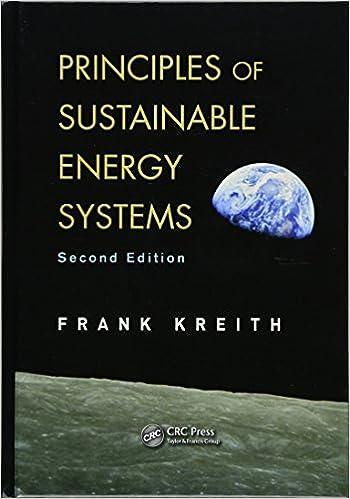The combustion of ethanol goes according to the following equation: [ mathrm{C}_{2} mathrm{H}_{5} mathrm{OH}+ldots mathrm{O}_{2} ightarrow
Question:
The combustion of ethanol goes according to the following equation:
\[ \mathrm{C}_{2} \mathrm{H}_{5} \mathrm{OH}+\ldots \mathrm{O}_{2} \rightarrow \ldots \mathrm{CO}_{2}+\ldots \mathrm{H}_{2} \mathrm{OLHV}=21 \mathrm{MJ} / \mathrm{L} \]
where \(\mathrm{LHV}=\) lower heating value, the symbol " \(\mathrm{L}\) " designates liter.
1. Calculate the amount of \(\mathrm{CO}_{2}\) produced in \(g\) per MJ of energy released (LHV). The density of ethanol at \(16^{\circ} \mathrm{C}\) is \(780 \mathrm{~g} / \mathrm{L}\).
The growth of corn and conversion of the corn into ethanol produce \(87 \mathrm{~g} \mathrm{CO}_{2} /\left(\mathrm{MJ}\right.\) of ethanol) from the fossil fuels required. In addition, \(35 \mathrm{~g}\) of \(\mathrm{CO}_{2} /\) (MJ of ethanol) is produced during the fermentation of corn sugar into ethanol. However, each atom of carbon in the corn sugar, and thus each atom of carbon in the \(\mathrm{CO}_{2}\) released by fermentation of the sugar, originally came from an atom of carbon dioxide in the atmosphere. Therefore, the \(\mathrm{CO}_{2}\) from the fermentation is "carbon neutral," that is, the amount of \(\mathrm{CO}_{2}\) released by the fermentation is balanced by \(\mathrm{CO}_{2}\) removed from the atmosphere in making the corn sugar. The same is true for the fermentation of any biomass. Likewise, each atom of \(\mathrm{C}\) in the \(\mathrm{CO}_{2}\) produced by combustion of ethanol is also carbon neutral.
2. Calculate the total amount of \(\mathrm{CO}_{2}\) released to the atmosphere per MJ (LHV) of ethanol made from corn and combusted, and the net amount of \(\mathrm{CO}_{2}\) released per MJ (LHV) of ethanol made from corn and combusted. The net amount is the amount by which the production and combustion of ethanol increase the amount of \(\mathrm{CO}_{2}\) in the atmosphere.
Gasoline is a mixture of many compounds of carbon and hydrogen, but may be represented by the formula \(\mathrm{C}_{8} \mathrm{H}_{16}\), with an \(\mathrm{LHV}\) of \(32.8 \mathrm{MJ} / \mathrm{L}(\mathrm{L}=\) liter).
3. Calculate the \(\mathrm{CO}_{2}\) emissions in \(\mathrm{g} \mathrm{CO}_{2} / \mathrm{MJ}\) (LHV) with gasoline as fuel.
4. Estimate the total \(\mathrm{CO}_{2}\) emissions \(\left[\mathrm{g} \mathrm{CO}_{2} / \mathrm{MJ}(\mathrm{LHV})\right]\) from "well-to-wheel" by including "well-to-tank" emissions with gasoline as a fuel. The well-to-tank energy efficiency for gasoline is approximately \(90 \%(100 \times\) (MJ energy to tank)/ (MJ energy of petroleum "in the well")). Assume that the ratio of \(\mathrm{CO}_{2}\) emissions from tank-to-wheel is also \(90 \%\) of the total \(\mathrm{CO}_{2}\) emissions.
Step by Step Answer:






